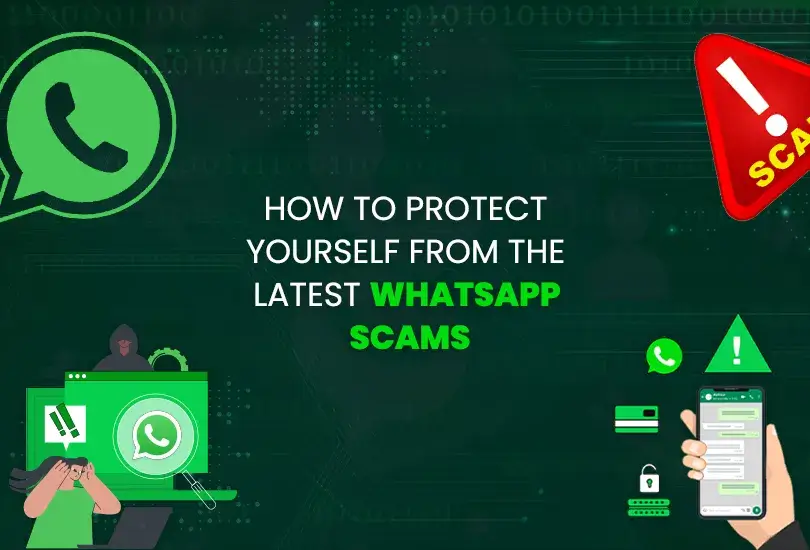Nowadays, various payment apps simplify life by quickly sending or receiving money globally. PayPal is among them and can make your life easy due to its numerous features. On the other hand, all these apps are unsafe as fraudsters target them to steal money personal and financial information. This article will discuss how to identify and avoid PayPal scams.
Common PayPal Scams and How to Identify Them
PayPal is a widespread app for transferring money online, other than online banking channels, and it makes it an easy mark for fraudsters, who are using various approaches to snip your money or your financial and personal details for their purposes.
According to PayPal, the following are some of the common scams to avoid
1. PayPal Phishing Scams
Phishing scam is one of the most common scams of PayPal. It attacks users by sending text messages and emails making them believe that those texts and emails are sent by PayPal, asking for sensitive user information. Fraudsters and scammers use this information to access your bank accounts or impersonate your identity on various platforms.
2. PayPal Invoice Scams
The invoice scam is also a trick that scammers play on consumers to steal their money or information. It can appear in multiple forms, such as:
- A payment request for something you didn’t order via PayPal, hoping you would click on the fake payment portal.
- Another method of PayPal scams involving invoices is sending you an invoice, prompting you to resolve an urgent issue regarding your order by calling from a fake customer support helpline, hoping to share your personal and financial information.
- Another common practice is sending you a fake email that looks like a real one sent by PayPal.
Do not entertain suspicious invoices or money transfer requests to avoid such scams. The easy way is to check an invoice you are not sure about from PayPal’s official website or call the official customer service helpline provided by PayPal.
3. PayPal Advance Payment Scams
In this scam category, a fraudster sends an email informing you that you have won a prize in a lucky draw or inherited cash from your late uncle; in other words, you are the lucky person who’s been awarded a big load of money.
The catch of this scam is to get a partial amount of money from you in the name of processing charges such as documentation fees, taxes, and transportation costs that need to be paid by you to claim your reward.
All of this is a con, and once you have paid the money, you realize that it was a scam and you are not getting any reward or an answer from the fraudster.
4. PayPal Shipping Scams
In the list there is another scam known as a shipping scam. In this scam, the fraudster usually uses a customer for something you sell online, tricking you into sending the package to a different address or using their advised courier mode.
It’s a common scam where the consumer offers to send a prepaid shipping label, which reroutes the package to different addresses. If you accepted this offer, the consumer later claimed they had never received the package and demanded a refund.
By sending the package to a different address, your business got damaged as you sent the package to a different address, as PayPal’s seller protection policy does not protect you. To avoid this scam, only send packages to the buyer’s address on the transaction details page.
5. PayPal Fake Charity Scams
Scammers often use disasters worldwide to trick people into donating sizable amounts to fake charities. This kind of scam happens when there is news of tragedy in local news channels or on other social media platforms, such as tsunami waves, earthquakes, and refugee crises in different countries across the globe.
To avoid this scam, make sure before donating that you are donating for the right reason and cause on a reliable and trustworthy platform.
6. PayPal Overpayment Scams
In this scam, a fraudster acts as a customer, overpays you for their order, and later asks you to return the excess amount through PayPal. The catch here is the payment made by the fraudster was by a stolen credit card or a check that usually bounces.
When the actual account holder notices and reports this unauthorized account activity, the money can be withdrawn via online banking refunds or other sources, leaving you without payment for the item you sent to the fraudster. You also lose the transportation cost, the money you transferred to the fraudster through PayPal, and your principal amount.
7. PayPal Bitcoin Scams
Cybercriminals often use cryptocurrency, such as Bitcoin, to con people online. In this case, a fraudster is pretending to be a seller or offering you an investment opportunity in cryptocurrency like Bitcoin and attempting a PayPal scam for Bitcoin.
If you send the requested payment via Bitcoin, it will be almost impossible to cover the damage as transactions via Bitcoin are irreversible.
8. PayPal refund Scams
Another scam on the list is the PayPal refund scam. In this category of scam, a fraudster would send a fake PayPal payment notification to a seller, which is almost like the legitimate one; they usually ship the item to the fraudster not realizing that the payment is not yet done.
Another way for the PayPal scam involving refunds is to convince the seller that the package has not yet reached the destination and the buyer wants the money back. By this, the buyer gets the money and the product he claimed not to be received.
To avoid this scam, always ensure everything is in order regarding a refund while processing a refund to the consumer.
How Do PayPal Scams Work?
There are various ways for PayPal scams, depending on the purpose of the fraud. Most PayPal scams are phishing scams that usually trick people into giving their personal and financial information to the fraudster through PayPal scam emails, so it can be helpful to access your account or impersonate your identity on various platforms.
Another way is a shipping scam. You must be careful regarding all your shipments if you are a seller. As mentioned above, a scammer might have sent you a prepaid shipping label to cover the transportation charges and an inadequate explanation that this would be cheaper than usual or at a discounted price.
In that scam, you would have no control over the destination of the item you have sent to the consumer if you use the label. Since the package is not sent to the buyer’s address mentioned on the transaction page of PayPal it won’t cover the seller protection policy of PayPal.
How to Avoid Scams on PayPal
PayPal is among one of the safe payment methods online. However, there are various ways to be scammed while completing a sale or purchase via PayPal.
The risks of falling victim to such scams can be minimized by taking the following safety measures and ensuring PayPal scam protection.
Be Wary of Links and Attachments
Never click on links or open suspicious attachments sent to you by unknown platforms and persons, even if they look genuine. Instead, always use your PayPal app or your PayPal web account to access your account and forward the suspicious content to [email protected].
Be Skeptical of Urgent Requests
Be wary of urgency as scammers continually try to make you do something immediately before you have time to consider whether the request is genuine.
Only Transact with Verified PayPal Users
PayPal’s verification process ensures that only authorized account holders use the platform with a valid bank account or credit card linked to the account. Users that are verified are not likely to be fraudsters.
Ignore Invoice or Money Requests You Don’t Recognize
Do not entertain suspicious money transfer requests, click on links in emails, or call phone numbers given in the request. Immediately report any suspicious email or text message to PayPal to ensure your account’s safety.
Never Send Money Outside of PayPal for Transactions
Never transfer money to an outside source through PayPal, as it might make you lose money. For example, if a consumer sends you an extra amount by accident and wants a refund of the excess amount, never refund the amount from an outside source.
Always Use Your Shipping Method
For sellers, it is advised to use the selling label listed on the transaction details page of PayPal so that you would be in control of the package destination and avoid being scammed by fake shipping destinations.
Contact PayPal Using the Official Listed Number on the Website
Never trust phone numbers in emails and text messages, as they are likely fake. Also avoid calling on phone numbers popping up in Google results, as they can be bogus. Always use the official numbers listed on the PayPal official website. Also, be aware that PayPal will always address you with your full name.
Use High-quality Antivirus Software
Always use a robust antivirus as scammers might upload malware and other viruses on your computer that might harm your files.
Is PayPal Safe?
It’s a commonly asked question: Is PayPal safe? The answer is simple. PayPal is among one of the secure payment methods online today. All transactions on PayPal are secured by advanced data encryption and sensitive user data such as bank account details and credit card information are kept hidden and secure.
Furthermore, a username and password are always required to proceed with a transaction, and you don’t have to give your bank account or credit card details to proceed with a transaction. Moreover, PayPal has a 24/7 fraud monitoring cell that sends alerts automatically for suspicious activities.
Does PayPal Protect Against Scams?
All transactions in PayPal are monitored constantly to reduce fraudulent activities, email phishing, and identity theft. The buyer protection of PayPal reimburses buyers in case of undelivered packages or poor seller descriptions.
Conversely, PayPal’s seller protection defends the users against any potential loss caused by scammers, excessive refunds, and unauthorized transactions.
In many cases, PayPal doesn’t cover the loss, such as sending a package to another address aside from the shipping address mentioned in the transaction details page of PayPal or delivering an item in person.
Follow These Tips to Spot Phishing Emails and Texts
According to recent data, most fraud attempts were made through emails and texts in 2022. As phishing scams are so common, identifying fake messages is essential. According to PayPal, here are some red flags for you:
- Phishing messages mostly contain greetings like Dear User or Hello PayPal member. PayPal never addresses its customers that way and always uses the full name in your profile.
- Attachments often contain malware that can harm your computer or smartphone, so open attachments from genuine sources.
- Scammers always try to rush you into making bad choices so don’t rush in making any decisions.
- Another common way is to send fake URLs in emails, pretending it is from PayPal.com. To identify the URL, hover the cursor over the link; if anything looks suspicious do not click the link to avoid unwanted troubles.
- Never provide your personal or financial information via emails or text messages, as they might be used to steal money or impersonate your identity over various social media platforms.
- Another way of identifying phishing messages is to check the messages for typos, grammatical mistakes, and misspelled words (e.g., We want u to give your bank account details to update your PayPal accounts).
Note: Always remember that if you receive a suspicious email containing links or attachments, never click the links. Instead, forward the email to [email protected] and then delete the email from your account.
Conclusion
PayPal is one of the most popular methods of sending and receiving payments, but it is also vulnerable to scams. People must take several measures to avoid falling victim to various PayPal scams. Some of the most common PayPal scams include phishing, invoices, advance payments, shipping, fake charity, overpayment, Bitcoin, and refunds.
Most PayPal scams use phishing emails or links to trap their targets and acquire funds. People can use several methods to avoid PayPal scams, including being careful of suspicious links or emails, evaluating urgent requests carefully, only transacting with verified users, ignoring unfamiliar funds or invoice requests, and avoiding using PayPal on insecure networks.







